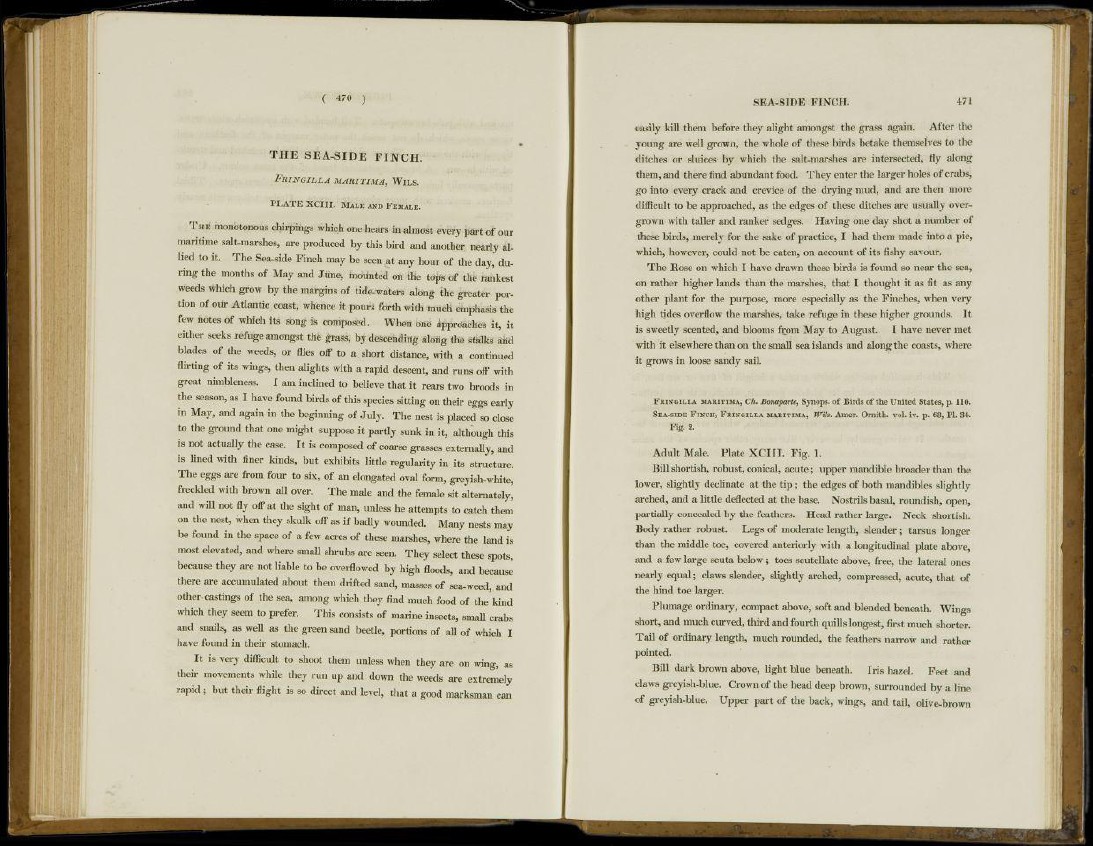
( 470 )
T H E SEA-SIDE FINCH.
FRINGILLA MARITIMA, WlLS.
P L A T E X C I I I . MALE AND FEMALE.
THE monotonous chirpings which one hears in almost every part of our
maritime salt-marshes, are produced by this bird and another nearly allied
to it. The Sea-side Finch may be seen at any hour of the day, during
the months of May and June, mounted on the tops of the rankest
weeds which grow by the margins of tide-waters along the greater portion
of our Atlantic coast, whence it pours forth with much emphasis the
few notes of which its song is composed. When one approaches it, it
either seeks refuge amongst the grass, by descending along the stalks and
blades of the weeds, or flies off to a short distance, with a continued
flirting of its wings, then alights with a rapid descent, and runs off with
great nimbleness. I am inclined to believe that it rears two broods in
the season, as I have found birds of this species sitting on their eggs early
in May, and again in the beginning of July. The nest is placed so close
to the ground that one might suppose it partly sunk in it, although this
is not actually the case. It is composed of coarse grasses externally, and
is lined with finer kinds, but exhibits little regularity in its structure.
The eggs are from four to six, of an elongated oval form, greyish-white,
freckled with brown all over. The male and the female sit alternately,
and will not fly off at the sight of man, unless he attempts to catch them
on the nest, when they skulk off as if badly wounded. Many nests may
be found in the space of a few acres of these marshes, where the land is
most elevated, and where small shrubs are seen. They select these spots,
because they are not liable to be overflowed by high floods, and because
there are accumulated about them drifted sand, masses of sea-weed, and
other castings of the sea, among which they find much food of the kind
which they seem to prefer. This consists of marine insects, small crabs
and snails, as well as the green sand beetle, portions of all of which I
have found in their stomach.
It is very difficult to shoot them unless when they are on wing, as
their movements while they run up and down the weeds are extremely
rapid ; but their flight is so direct and level, that a good marksman can
SEA-SIDE FINCH. 471
easily kill them before they alight amongst the grass again. After the
young are well grown, the whole of these birds betake themselves to the
ditches or sluices by which the salt-marshes are intersected, fly along
them, and there find abundant food. They enter the larger holes of crabs,
go into every crack and crevice of the drying mud, and are then more
difficult to be approached, as the edges of these ditches are usually overgrown
with taller and ranker sedges. Having one day shot a number of
these birds, merely for the sake of practice, I had them made into a pie,
which, however, could not be eaten, on account of its fishy savour.
The Rose on which I have drawn these birds is found so near the sea,
on rather higher lands than the marshes, that I thought it as fit as any
other plant for the purpose, more especially as the Finches, when very
high tides overflow the marshes, take refuge in these higher grounds. It
is sweetly scented, and blooms from May to August. I have never met
with it elsewhere than on the small sea islands and along the coasts, where
it grows in loose sandy sail.
FRINGILLA MARÍTIMA, Ch. Bonaparte, Synops. of Birds of the United States, p. 110.
SEA-SIDE FINCH, FRINGILLA MARÍTIMA, Wils. Amer. Ornith. vol. iv. p. 68, PI. 34.
Fig. 2.
Adult Male. Plate XCIII. Fig. 1.
Bill shortish, robust, conical, acute; upper mandible broader than the
lower, slightly declínate at the tip; the edges of both mandibles slightly
arched, and a little deflected at the base. Nostrils basal, roundish, open,
partially concealed by the feathers. Head rather large. Neck shortish.
Body rather robust. Legs of moderate length, slender; tarsus longer
than the middle toe, covered anteriorly with a longitudinal plate above,
and a few large scuta below ; toes scutellate above, free, the lateral ones
nearly equal; claws slender, slightly arched, compressed, acute, that of
the hind toe larger.
Plumage ordinary, compact above, soft and blended beneath. Wings
short, and much curved, third and fourth quills longest, first much shorter.
Tail of ordinary length, much rounded, the feathers narrow and rather
pointed.
Bill dark brown above, light blue beneath. Iris hazel. Feet and
claws greyish-blue. Crown of the head deep brown, surrounded by a line
of greyish-blue. Upper part of the back, wings, and tail, olive-brown